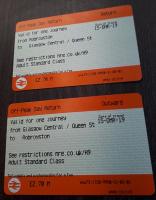Garnkirk and Glasgow Railway
Introduction
This railway ran east from Glasgow to near Coatbridge, where it met the Monkland and Kirkintilloch Railway. This line is open, save for the original Glasgow Townhead terminus.
The line was renamed the Glasgow, Garnkirk and Coatbridge Railway when it was opened through from Gartsherrie to Whifflet via Coatbridge Central in 1844.
This was the first public railway in Scotland and it was also the first to compete with a canal - the Monkland Canal (and to a certain extent the Monkland and Kirkintilloch Railway and Forth and Clyde Canal route to Glasgow).
Dates
| / /1825 | Charles Tennant Charles Tennant, one of the promoters of the Garnkirk and Glasgow Railway, visits the Stockton and Darlington Railway with his family. Local suppliers and mines further afield via the Monkland Canal were struggling to meet the coal demands of the St Rollox Chemical Works. |
| /05/1826 | Garnkirk and Glasgow Railway Act receives Royal assent. The promoters were Charles Tennant, Mark Sprot, George M. Nisbett, John Land, James Jeffray, Thomas Sprot, William Dixon [Junior] , Archibald Lamont and James Merry. |
| / /1830 | Charles Tennant Charles Tennant, one of the promoters of the Garnkirk and Glasgow Railway, visits the Liverpool and Manchester Railway with his family. |
| / /1831 | Garnkirk and Glasgow Railway Two locomotives provided by George Stephenson. |
| /05/1831 | Garnkirk and Glasgow Railway Railway comes into use for mineral traffic. The line is double track, 4ft 6in gauge, and worked by both horses and locomotives. At the western end the St Rollox Chemical Works is served and a coal depot St Rollox Depot is opened. |
| 31/05/1831 | Monkland and Kirkintilloch Railway Coach service between Kirkintilloch Basin and Leaend ceased. This was due to the opening of the Garnkirk and Glasgow Railway in May and the commencing of a through coach service to Leaend from Glasgow Townhead. |
| 01/06/1831 | Garnkirk and Glasgow Railway Glasgow (Townhead) and Gartgill (Gartsherrie) stations opened at either end of the line. |
| 01/06/1831 | Garnkirk and Glasgow Railway Monkland and Kirkintilloch Railway Ballochney Railway Commencement of a service to Airdrie. Coaches for Airdrie Leaend are disconnected from the trains on arrival at Gartgill/Gartsherrie and taken on by horse to Leaend. |
| 27/09/1831 | Garnkirk and Glasgow Railway Glasgow (Townhead) to Gartgill (Gartsherrie) opened officially. |
| / /1832 | Garnkirk and Glasgow Railway Gartgill station renamed Gartsherrie [GGR]. |
| / /1832 | St Rollox Chemical Works By 1832 the works is consuming 30,000 tonnes of coal annually, brought to the works along the Garnkirk and Glasgow Railway. |
| 31/05/1834 | Wishaw and Coltness Railway
Monkland and Kirkintilloch Railway
Garnkirk and Glasgow Railway Cleland Branch, Holytown [1st] to Newarthill, opened for minerals. (Not long afterwards a passenger service from Newarthill with the carriage joining Glasgow Townhead trains at Gartsherrie [GGR] was introduced. It ran from Newarthill in the morning and back in the afternoon/evening.) |
| / /1837 | Garnkirk and Glasgow Railway Gartcosh and Garnkirk stations opened. |
| / /1840 | Garnkirk and Glasgow Railway Engine house (locomotive shed) opened, Gartsherrie Shed. |
| 31/08/1840 | Slamannan Railway
Ballochney Railway
Monkland and Kirkintilloch Railway
Garnkirk and Glasgow Railway Passenger service from Edinburgh to Glasgow introduced by the Slamannan Railway. A trackboat along the Union Canal from Edinburgh to Causewayend Basin was followed by a train from Causewayend [SR] to Arbuckle along the Slamannan Railway. Running powers were then used from Arbuckle to Kipps via the Ballochney Railway, from Kipps to Gartsherrie [GGR] via the Monkland and Kirkintilloch Railway and Gartsherrie to Glasgow Townhead over the Garnkirk and Glasgow Railway. (Alternative date 05 August.) |
| / /1841 | Garnkirk and Glasgow Railway Garnkirk and Glasgow Railway buys land in Coatbridge with the intention of building an independent extension to the town. This later opened as Coatbridge [CR]. |
| / /1842 | Cut of Junction The portion of canal between St Rollox Depot/Glasgow (Townhead) (Garnkirk and Glasgow Railway) and Port Dundas Basin is improved by increasing the canal depth. This portion was originally only 4ft deep (depth of the Monkland Canal) which prohibited the larger coal boats of the Forth and Clyde Canal reaching St Rollox. The railway depot was rebuilt and enlarged in the 1840s. |
| / /1842 | Garnkirk and Glasgow Railway Extended from Gartsherrie to Coatbridge [CR]. This was built without an Act of Parliament. |
| / /1843 | Garnkirk and Glasgow Railway Garnkirk and Glasgow Railway renamed the Glasgow, Garnkirk and Coatbridge Railway for its extension to Coatbridge [CR] (and the still relatively new Summerlee Iron Works of 1836). |
| /02/1843 | Glasgow, Garnkirk and Coatbridge Railway Garnkirk and Glasgow Railway extended from Gartsherrie to new Coatbridge [CR], initially a terminus. (This line later extended through to Whifflet South Junction and was used by the Wishaw and Coltness Railway and the Caledonian Railway to avoid the more tortuous Monkland and Kirkintilloch Railway route with level crossings through Coatbridge.) |
| /05/1843 | Garnkirk and Glasgow Railway Coatbridge [CR] opened to passengers. Connecting service to Leaend on the Ballochney Railway abandoned. An omnibus continued the journey from Coatbridge to Airdrie. |
| /05/1843 | Slamannan Railway With the Garnkirk and Glasgow Railway opening to Coatbridge [CR] and withdrawing from Leaend the Slamannan passenger service is cut back, running from Rawyards (Ballochney Railway) to Causewayend [SR]. |
| / /1844 | Neilson & Mitchell Build locomotives for the Garnkirk and Glasgow Railway. |
| /07/1844 | Garnkirk and Glasgow Railway
Glasgow, Garnkirk and Coatbridge Railway With the extension to Coatbridge [CR] in use the line is renamed the Glasgow, Garnkirk and Coatbridge Railway. An Act of Parliament authorises the Gartsherrie to Summerlee Iron Works and Coatbridge section along with the extension to the Wishaw and Coltness Railway at Whifflet. Alteration of the gauge is also authorised. |
| 01/03/1845 | Edinburgh and Glasgow Railway Passenger service from Glasgow Queen Street to Coatbridge [NB] and Airdrie (Commonhead?) begins around this date. This used the Edinburgh and Glasgow Railway, Garngaber Curve (Monkland and Kirkintilloch Railway), Monkland and Kirkintilloch Railway and Ballochney Railway. The Monkland line was upgraded for this service and began to use steam hauled passenger trains. This new service ran in competition with that from Glasgow Townhead over the Garnkirk and Glasgow Railway to Coatbridge [CR] with a road coach connection to Airdrie. |
| / /1848 | Garnkirk and Glasgow Railway Caledonian Railway buys land at St Rollox. This will later be the site of the St Rollox Works. |
| 01/11/1849 | Garnkirk and Glasgow Railway Glasgow (Townhead) to Milton Junction closed to passengers. |
| / /1854 | Garnkirk and Glasgow Railway The Caledonian Railway opens the St Rollox Works between the original line's alignment and the new Buchanan Street Extension (Caledonian Railway). The works built and maintained locomotives and rolling stock. (Alternative date 1856.) Greenock Works and Shed on the Glasgow, Paisley and Greenock Railway - workshops abandoned. |
| / /1865 | Garnkirk and Glasgow Railway Authorisation to stop up the Gartgill Level Crossing at Gartsherrie North Junction directly west of Gartsherrie station. The road is relocated to the west to cross a bridge. |
| / /1866 | Garnkirk and Glasgow Railway Gartsherrie Shed [GGR] closed on the opening of Motherwell Shed. |
| / /1870 | Garnkirk and Glasgow Railway Villas start being built at Steps Road. |
| / /1878 | Garnkirk and Glasgow Railway Level crossing to the east of Steps Road is stopped up and replaced with a bridge. |
| / /1882 | Garnkirk and Glasgow Railway St Rollox Works extension opened. |
| / /1886 | Garnkirk and Glasgow Railway St Rollox Works remodelled and enlarged. |
| /09/1887 | Garnkirk and Glasgow Railway
Buchanan Street Extension (Caledonian Railway) St Rollox Goods ceased to forward mineral traffic. |
| 01/11/1898 | Garnkirk and Glasgow Railway Original Robroyston station opened. |
| / /1924 | Garnkirk and Glasgow Railway Steps Road renamed Stepps [1st]. |
| / /1930 | Garnkirk and Glasgow Railway Cardowan Colliery opened by line at Stepps. |
| 28/10/1940 | Garnkirk and Glasgow Railway Gartsherrie station closed. |
| / /1948 | Garnkirk and Glasgow Railway Coatbridge [CR] station renamed Coatbridge Central. |
| 11/06/1956 | Garnkirk and Glasgow Railway Robroyston station closed. |
| 07/03/1960 | Garnkirk and Glasgow Railway Garnkirk station closed. |
| / /1962 | Aberdeen Joint (Caledonian Railway)
Aberdeen Railway
Arbroath and Forfar Railway
Scottish Midland Junction Railway
Scottish Central Railway
Caledonian Railway
Garnkirk and Glasgow Railway
Buchanan Street Extension (Caledonian Railway) A4 Pacifics introduced on the Aberdeen to Glasgow Buchanan Street 3 hour Grampian run. |
| 05/11/1962 | Garnkirk and Glasgow Railway Gartcosh station closed. |
| 05/11/1962 | Garnkirk and Glasgow Railway Whifflet [CR] station closed. |
| 05/11/1962 | Garnkirk and Glasgow Railway Gartcosh Junction to Gartsherrie South Junction closed to regular stopping passenger services. |
| 03/09/1966 | Aberdeen Joint (Caledonian Railway)
Aberdeen Railway
Arbroath and Forfar Railway
Scottish Midland Junction Railway
Scottish Central Railway
Caledonian Railway
Garnkirk and Glasgow Railway
Buchanan Street Extension (Caledonian Railway) A4 Pacifics from Aberdeen to Glasgow Buchanan Street withdrawn. |
| 24/07/1968 | Garnkirk and Glasgow Railway Glasgow (Townhead) to Milton Junction closed. |
| 24/07/1968 | Garnkirk and Glasgow Railway Townhead (St Rollox Goods West) to St Rollox Works closed to goods. |
| 30/11/1968 | Garnkirk and Glasgow Railway Sighthill East Junction to Germiston Junction Low closed. |
| 03/05/1976 | Garnkirk and Glasgow Railway Gartcosh Junction to Gartsherrie South Junction re-opened to passengers. |
| 11/08/1981 | Garnkirk and Glasgow Railway
Wishaw and Coltness Railway Coatbridge Freightliner Terminal to Mossend Marshalling Yard electrified. |
| / /1987 | Garnkirk and Glasgow Railway British Rail Engineering Limited stop using St Rollox Works. MC Metals continue to use the sidings for asbestos removal from stock and locomotives. |
| 15/05/1989 | Garnkirk and Glasgow Railway Stepps station opened. Served by the Springburn to Cumbernauld services, and Greenfaulds opened on the same day. |
| 04/10/1993 | Garnkirk and Glasgow Railway Whifflet station opened |
| /05/1999 | Garnkirk and Glasgow Railway Gartsherrie South Junction signal box closes - last signal box in the Monklands. |
| 30/01/2013 | Garnkirk and Glasgow Railway Caledonian Railway Carillion wins contract to electrify the line to Cumbernauld. |
| 19/05/2014 | Garnkirk and Glasgow Railway
Caledonian Railway Electric passenger services begin operating between Glasgow and Cumbernauld following commissioning of 50 km of 25 kV 50 Hz electrification between Springburn and Cumbernauld. |
| 12/08/2018 | Garnkirk and Glasgow Railway Work begins to open a new Robroyston station. The station cost £14m to re-build. |
| 15/12/2018 | Garnkirk and Glasgow Railway Robroyston station opened. |
Portions of line and locations
This line is divided into a number of portions.
Glasgow to Gartsherrie
This was the Glasgow terminus of the Garnkirk and Glasgow Railway. It was on the north bank of the Monkland Canal just east of the Port Dundas Basin. The depot was chiefly a mineral depot with several sidings serving coal staithes on the canal, very much expanded in the 1840s after the site ceased to serve passengers - a curve in the line betrays where the westwards extension began. ...
More detailsSee also
Port Dundas Branch (Caledonian Railway)
Monkland Canal
This was an early passenger terminus in Glasgow opened in 1831. Known variously as
...
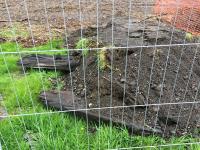
Martin MacGuire 18/05/2016
A shed and works existed on the east side of Glebe Street and north side of the railway close to the Glebe Street terminus. It was replaced by Inchbelly Works to the east.
...
This mineral depot was east of Glebe Street (Pinkston Road) and approached from the east. The fan of lines was north of the Garnkirk line. Glebe Street Works was located by the street. To the south, over the railway, was the St Rollox Chemical Works. An extension of the works was built to the north of the goods depot. Waste material was deposited to the north.
...
This large chemical works, once the largest in the World, was in the north of Glasgow (229 Castle Street). It started by producing bleaching chemicals for cloth. The works was built on the north bank of the Forth and Clyde Canal / Monkland Canal Cut of Junction (the link between the canals). It was most famous for it's huge chimney dating from 1842, the 'St Rollox Stalk', which was 435.5 ...
More detailsSee also
Monkland Canal
This gate box was at the Inchbelly Level Crossing in Glasgow, on the former 1831 Garnkirk and Glasgow Railway east of the original Glasgow terminus.
...
This locomotive shed and works was opened by the Garnkirk and Glasgow Railway to replace a small shed and works at Glebe Street Works. The name is contrived, it was probably just known as the Glasgow shed and works of the Garnkirk company.
...
This junction was formed between the 1831 Garnkirk and Glasgow Railway and a connection to the 1849 Buchanan Street Extension (Caledonian Railway) at Sighthill East Junction. The connecting line had several uses:
...
This location was between Locomotive Sheds Junction (to the west) and Germiston Junction High to the east on the original Garnkirk and Glasgow Railway approach to the St Rollox Depot. After the opening of Buchanan Street this became a goods only route. There were a pair of looped sidings on the north side of the line.
...
This was the junction between the Milton Junction to St Rollox [1st] (the original terminus) line and The Switchback line south to Rutherglen. This curve closed in 1962.
...
See also
Blochairn Steel Works Branch (Caledonian Railway)
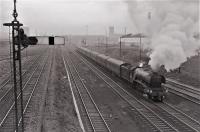
Robin McGregor 07/05/1963

Robin McGregor 29/10/1966
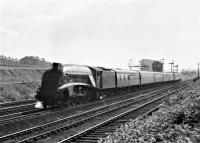
Robin McGregor 27/07/1963
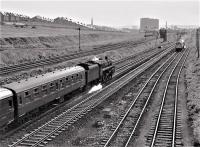
Robin McGregor 27/07/1963
At this junction the lines from the original Glasgow terminus of the 1831 Garnkirk and Glasgow Railway at St Rollox [1st] was met by the later (1849) line to the more suitable terminus at Glasgow Buchanan Street. The former, the southern pair of lines, also served the St Rollox Works. The latter, the northern pair of lines, also served Balornock Shed. After the opening of ...
More detailsSee also
Buchanan Street Extension (Caledonian Railway)
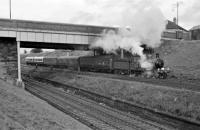
Robin McGregor 19/04/1965
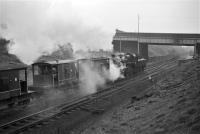
...
Robin McGregor 08/04/1966
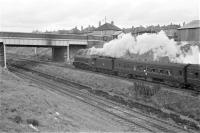
Robin McGregor 19/04/1965
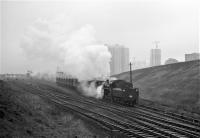
Robin McGregor 08/04/1966
This junction was named Millerston Junction for one year. It was the western approach to Robroyston station and Robroyston Yard.
...
See also
Robroyston Marshalling Yard and Colliery Branches (Caledonian Railway)
A new station opened at Robroyston in 2019, a little east of the original station. Work started in September 2018. The new station will be built on the site of its predecessor with the car park on some of the former Robroyston Yard. It will be Glasgow's 60th station.
...
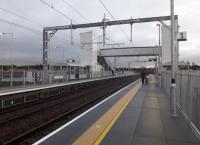
John Yellowlees 15/12/2019
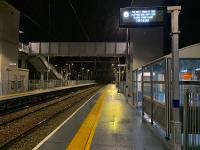
Colin McDonald 14/12/2019
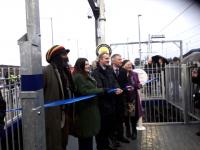
John Yellowlees 16/12/2019
This junction predates the former Robroyston Yard to its west. This was the junction for a mineral line serving Robroyston Coal Pit, the branch being approached from the east.
...
See also
Robroyston Marshalling Yard and Colliery Branches (Caledonian Railway)
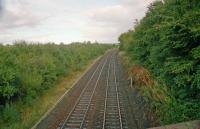
Ewan Crawford //2000
This station was on the east side of Cumbernauld Road, for which it was briefly named, close to the road bridge. It was a two platform station in Caledonian style with the main building on the westbound platform.
...
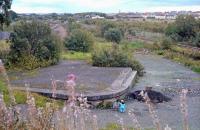
Ewan Crawford //1988
This is a two platform station.
...
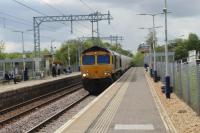
Alastair McLellan 03/05/2019
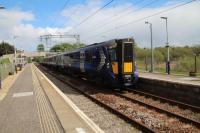
...
Alastair McLellan 03/05/2019
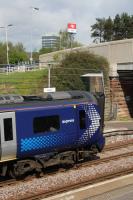
Alastair McLellan 03/05/2019
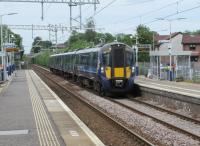
David Panton 22/06/2019
The original signal box was on the north side of the line and in the 'V' of the junction of the line leading to Cardowan Fireclay Works, approached from the east.
...
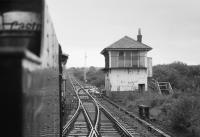
Bill Roberton 31/08/1985
Sources vary for the opening date of this works, with some suggesting a clay works here predated the Garnkirk and Glasgow Railway of 1831 which was built alongside and which served it. Certainly it was open by 1832 when the Garnkirk Colliery and Brickfield Company was formed. Mark Sprot of Garnkirk House and the Garnkirk and Glasgow Railway was involved. The clay dug for and used ...
More detailsThis station had two platforms, the eastbound platform being an island with possibly a second face on its north side. The main station building and signal box were on the westbound platform.
...
This signal box was west of Gartcosh station. It controlled access to the Gartcosh Fireclay Works siding which was on the south side of the line and approached from the west with an exchange siding laid alongside the main line.
...
This fireclay works, making firebricks and a wide range of other objects such as garden ornaments, fountains, roof tiles and pipes, was opened by James Binnie in 1863. The works closed in the 1950s.
...
This is a modern minimal two platform station. It was opened in 2005 on the site of the previous Gartcosh station, closed in 1962.
...
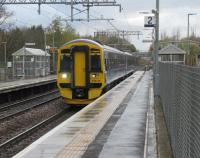
David Panton 25/10/2018
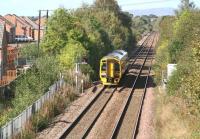
John Furnevel 25/09/2007
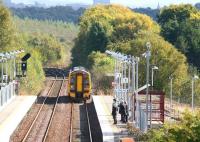
John Furnevel 25/09/2007
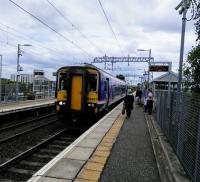
...
David Panton 02/09/2017
This is the junction between the line west to Glasgow via Stepps and east to Cumbernauld (to the north east) and Coatbridge Central (to the south east). The Cumbernauld route is double track, Coatbridge Central route single track.
...
See also
Hayhill Branch (Caledonian Railway)
Gartcosh Steelworks (British Steel Corporation)
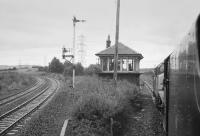
Bill Roberton 31/08/1985
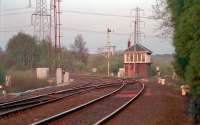
Ewan Crawford //1999
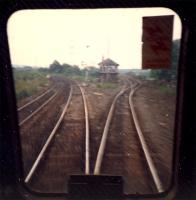
Ewan Crawford //1987

Ewan Crawford //1987
This signal box was located between Gartsherrie North Junction to Gartcosh Junction and provided access to Kilgarth Slag Hill which was within the triangle of lines formed by Gartcosh Junction - Garnqueen North Junction - Gartsherrie South Junction.
...
This was the junction between the 1831 Garnkirk and Glasgow Railway and its 1843/5 branch to Coatbridge Central.
...
See also
Whifflet Extension (Glasgow, Garnkirk and Coatbridge Railway)
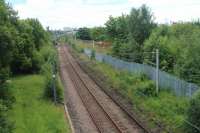
...
Alastair McLellan 29/07/2017
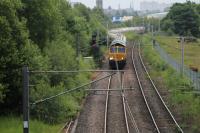
Alastair McLellan 29/06/2019
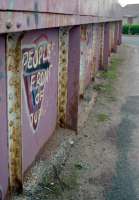
Ewan Crawford 03/05/1997
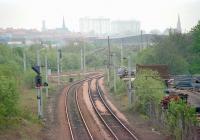
The Garnkirk and Glasgow Railway's 1831 alignment was a little ...
Ewan Crawford //1989
This station opened on the Monkland and Kirkintilloch Railway just east of the junction formed with the opening of the Garnkirk and Glasgow Railway in 1831.
...
See also
Monkland and Kirkintilloch Railway
Gartsherrie Ironworks and Railways (William Baird & Co)
Port Dundas West Goods Branch
This very short branch extended north from St Rollox Depot up the east side of the Port Dundas Basin.
This was the Glasgow terminus of the Garnkirk and Glasgow Railway. It was on the north bank of the Monkland Canal just east of the Port Dundas Basin. The depot was chiefly a mineral depot with several sidings serving coal staithes on the canal, very much expanded in the 1840s after the site ceased to serve passengers - a curve in the line betrays where the westwards extension began. ...
More detailsSee also
Port Dundas Branch (Caledonian Railway)
Monkland Canal
This power station generated electricity for the Glasgow Corporation Tramways. It was located on the east side of the Forth and Clyde Canal's Port Dundas Basin and the west side of the Edinburgh and Glasgow Railway where it entered Cowlairs Tunnel.
...
See also
Port Dundas Branch (Edinburgh and Glasgow Railway)










